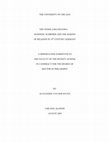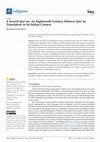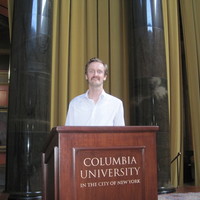Books by Alexander van der Haven
שרה האשכנזיה מלכת השבתאים הוא מחקר יוצא דופן המביא את סיפורה המרתק של שרה האשכנזיה, מלכתו של המשי... more שרה האשכנזיה מלכת השבתאים הוא מחקר יוצא דופן המביא את סיפורה המרתק של שרה האשכנזיה, מלכתו של המשיח שבתי צבי, ושופך אור על תפקידה בתנועה השבתאית. המחקר מתאר כיצד, בשנים שלפני נישואיה לשבתי צבי, רכשה שרה לא רק מוניטין של פריצות אלא גם כישרון ניכר לשכנע אחרים בכישוריה הדתיים, ובכלל זה טענתה כי היא עתידה להינשא למלך המשיח. בחצר המשיחית של שבתי צבי נקלעה שרה למאבקי כוחות עם נביא התנועה הסגפן נתן העזתי וסירבה להסכין עם התפקיד הכנוע שביקשו לייחס לה, רעיה המשמשת כמטאפורה של השכינה לפי תורת הסוד הקבלית. במקום זאת, ובשידוד מערכות רוחני דרמטי שיהדהד כעבור מאות שנים בהגותם של כותבים, כגון דייוויד יום, לודוויג פויירבך וזיגמונד פרויד, מילאה שרה - כך טוען מחקר מרתק זה - תפקיד מכונן באופייה החתרני, האל-מטאפורי, של התנועה השבתאים המאוחרת.

Der Sammelband widmet sich dem "religiösen Wahnsinn", wie er insbesondere in den Jahrzehnten um d... more Der Sammelband widmet sich dem "religiösen Wahnsinn", wie er insbesondere in den Jahrzehnten um das Jahr 1900 gesellschaftlich und diagnostisch etabliert und verhandelt wurde. Die Herausgeber gehen davon aus, dass Fälle "religiösen Wahnsinns" bisher vorwiegend aus psychologischer Perspektive bearbeitet und als Beispiele pathologischer Erkrankungen beschrieben wurden. Eine interdisziplinäre Betrachtung des Themas soll hingegen die Schnittstellen zwischen Religion, Medizin, Psychologie und Gesellschaft sowie deren dynamische Grenzverschiebungen bzw. diskursive Verwobenheit hervorheben. Die Beiträge legen daher den Fokus einerseits auf konkrete Einzelbeispiele jenseits der in der Literatur bekannten und prominenten "Psychofälle" und diskutieren andererseits systematische Fragen zur gegenseitigen Konstituierung von religiösen Sinnsystemen, zeitgenössischen Krisenrhetoriken sowie "wissenschaftlicher" und "pseudowissenschaftlicher" Diagnostik und Therapie. Ein besonderes Interesse liegt zudem auf dem Diskurs über "religiöse und psychische Devianz", der nicht allein die Pathologisierung "religiösen Wahnsinns" ermöglichte, sondern gleichsam der Selbstermächtigung des religiösen Subjekts und dessen Befreiung aus den gesellschaftlichen Zwängen der Moderne Vorschub leistete. Eine zentrale These ist dabei, dass solche "Anormalitätsdiskurse" und deren breite Rezeption in Wissenschaft, Kunst und Religion den gesellschaftlichen und individuellen Umgang mit den Ambivalenzen und Chancen der Moderne widerspiegeln und dies insbesondere am Beispiel des "religiösen Wahnsinns" zu Tage tritt.
This book takes issue with the prevalent view that Sarah the Ashkenazi, third wife of the 17th ce... more This book takes issue with the prevalent view that Sarah the Ashkenazi, third wife of the 17th century Jewish messiah Sabbatai Tsevi, was insignificant in the Sabbatian movement and will show that her role was not only important but also indispensable to the eventual domination of the antinomian element in the movement. From my reading of the contemporary sources reporting about her I conclude that despite the attempts by Sabbatai Tsevi and especially Nathan of Gaza to control her, Sarah occupied a powerful position in the Sabbatian messianic court and resisted being confined to the role of lowly earthly wife and queen who was just a metaphor of a divine female quality. Her refusal to regard female and erotic, mystical imagery as strictly metaphorical fostered the radical Sabbatian transference of mystical action from a cosmic to an earthly plane.

The religious experiences and religious cosmology that the psychiatric patient Daniel Paul Schreb... more The religious experiences and religious cosmology that the psychiatric patient Daniel Paul Schreber (1842-1911) described in his memoirs have since their publication in 1903 been interpreted by psychiatrists such as Freud and Lacan as pathological symptoms of an individual mental illness. This dissertation follows however other attempts to place Schreber's Denkwürdigkeiten eines Nervenkranken in the context of its time, namely by presenting it as the product of a clash of two worldviews. The religious cosmology and experiences that Schreber described were constructed from the dualist transcendent worldview of Schreber's upbringing, and the monist worldview it pitted against, namely that of evolutionist popular-scientists and of psychiatrists who influenced Schreber in the years before his illness. I argue that special characteristics of Schreber's experiences and arguments that can be seen as pathological now emerge as expressions of transcendental dualist cultural concerns or of consequences of an immanent monist worldview. To these belong the disasters Schreber believed resulted from hypnosis allegedly performed on him, the very physical character of Schreber's experiences, his reservations about the ability of language as a tool for revelation, and a new notion of divinity as a mere part of nature. As a result, Schreber's Denkwürdigkeiten emerge as another Zarathustra, as an unusual religious revelatory document engaged with and representative of central religious issues of its time.
Articles and Book Chapters by Alexander van der Haven

Method & Theory in the Study of Religion, 2024
In his book Why Study Religion? ethicist and philosopher Richard B. Miller criticizes the discipl... more In his book Why Study Religion? ethicist and philosopher Richard B. Miller criticizes the discipline of religious studies for being negligent about the fundamental goal of its academic pursuits. In this review essay, the authors challenge Miller’s diagnosis by arguing that scholars of religion do share a common goal and that the state of affairs bemoaned by Miller is healthier than he admits. The essay raises doubts concerning his selection of six “methodologies” that supposedly represent the field and it challenges Miller’s interpretation of Jonathan Z. Smith’s famous comparative analysis of the Jonestown massacre. The essay proposes a different distinction between goals and values in research and critically reviews the four goals/values proposed by Miller, three of which appear to represent business as usual. The essay argues that Miller’s proposed teleology is suspicious, not as innovative as he seems to think, and maybe even a retrogression. Finally, the essay faults Miller’s un...
Religious Minorities Online, 2023

Religions, 2023
This essay places the Washington Library of Congress Heb. Ms 183, a Hebrew Qur’an
translation fro... more This essay places the Washington Library of Congress Heb. Ms 183, a Hebrew Qur’an
translation from eighteenth-century Cochin, in its South Indian context. After pointing out important
general differences between early modern European and South Asian inter-religious cultures and
attitudes to translation, this essay analyzes three salient differences between Ms 183 and its Dutch
source. Then, the essay scrutinizes three relevant and interrelated contexts: the eighteenth-century
Indian diplomatic culture of owning and exchanging scriptural translations; the social position of
Muslims and Jews as ‘guests’ and diplomatic brokers; and the rise of Muslim military power in
Malabar. On this basis, I argue that this Hebrew Qur’an translation was intended to be cultural–
diplomatic capital for Jewish diplomats dealing with Muslim rulers, indicating that not only rulers
translated the scriptures of their subjects but also subjects those of their rulers. In addition, by
showing how the Mysorean rulers implemented Islamic reforms and how Jewish practices were
attuned to majoritarian religious practices, the essay suggests that Ms 183 was also meant to serve
Jewish religious purposes, making this manuscript possibly a rare instance of using non-Jewish
religious scriptures for Jewish religious practice.
Studia Rosenthaliana: Journal of the History, Culture and Heritage of the Jews in the Netherlands, 2021
The 1768-9 Cópia da vida de bemaventurado, claiming to be a copy of
text written by Manoel Cardos... more The 1768-9 Cópia da vida de bemaventurado, claiming to be a copy of
text written by Manoel Cardoso de Macedo who later adopted the name
Abraham Pelengrino (d. 1652), is a unique testimony of an early modern
conversion to Judaism, a phenomenon of which few descriptions have
survived. The English translation of the Portuguese original presented in
this article shows, among others, how such conversions were deeply personal experiences while at the same time served converts’ apologetic needs and, possibly, the Jewish community’s anti-Christian polemics. The essay that introduces the translation addresses questions of authorship, genre, and, focusing on discrepancies between facts described in the text and other sources, explores the Vida as a literary construct.

HOFFNUNG ist die Verwechselung des Wunsches einer Begebenheit mit der Wahrscheinlichkeit. Aber vi... more HOFFNUNG ist die Verwechselung des Wunsches einer Begebenheit mit der Wahrscheinlichkeit. Aber vielleicht ist kein Mensch frei von der Narrheit des Herzens, welche dem Intellekt die richtige Schätzung der Propabilität so sehr verrückt, daß er Eins gegen Tausend für einen leicht möglichen Fall hält. Und doch gleicht ein hoffnungsloser Unglücksfall einem raschen Todesstreich, hingegen die stets vereitelte und immer wieder auflebende Hoffnung der langsam marternden Todesart. Wen die Hoffnung, den hat auch die Furcht verlassen: dies ist der Sinn des Ausdrucks »desperat«. Es ist nämlich dem Menschen natürlich, zu glauben, was er wünscht, und es zu glauben, weil er es wünscht. Wenn nun diese wohlthätige, lindernde Eigenthümlichkeit seiner Natur durch wiederholte, sehr harte Schläge des Schicksals ausgerottet und er sogar, umgekehrt, dahin gebracht worden ist, zu glauben, es müsse geschehn was er nicht wünscht, und könne nimmer geschehn was er wünscht, eben weil er es wünscht; so ist dies eigentlich der Zustand, den man Verzeiflung genannt hat.

Studia Rosenthaliana, 2020
Numerous religious texts were printed that would have been censored, elsewhere including Jewish r... more Numerous religious texts were printed that would have been censored, elsewhere including Jewish religious texts. Yet freedom had its limits. In August 1701, Amsterdam’s judiciary council ordered the books authored by the Danish visionary Oliger Paulli, who advocated for a new religion uniting Jews and Christians, to be destroyed. In addition, the council sentenced Paulli to twelve years, imprisonment and later to permanent banishment, while two of his printers received hefty fines for printing his books. While earlier accounts have explained Paulli’s arrest by pointing to his heretical ideas, Paulli had publicly been advocating his views without causing scandal for years. The present chapter explores an alternate reason for his arrest, focusing on his printing connections that year, which caused Amsterdam’s authorities to associate Paulli with some of Amsterdam’s most outspoken religious dissenters and critics of religious authority.
European Genizah Newly Discovered Hebrew Binding Fragments in Context, 2020
Whereas early modern eschatology is often exclusivist of nature, some eschatological thinkers ima... more Whereas early modern eschatology is often exclusivist of nature, some eschatological thinkers imagined a different form of End. This article explores an example of this and its various religious contexts, namely two letters written from Amsterdam in 1682 in which Benedictus Sebastian Sperling explained to his mother in Hamburg the ground for his conversion from Lutheranism to Judaism. These letters reflect several subcultures that grounded religious conversion and prophecies of the end of time in a concept of ‘religion’ that, despite tending to declare the 'truth' of one religion over the others, was not exclusivist.
Zutot: Perspectives on Jewish Culture, 2019
A record from 1 November 1655 of a donation to a certain Sarah from Poland is probably the first ... more A record from 1 November 1655 of a donation to a certain Sarah from Poland is probably the first documented historical appearance of Sarah the Ashkenazi, future wife of messiah Shabbetai Tzevi. Individually recorded donations by the Sephardic community to Polish refugees were quite unusual in these years, but, according to later biographical sources, the future messianic bride Sarah displayed a great talent for persuading others, and this explains why Amsterdam’s Portuguese Mahamad would give her money. Arriving as a Polish refugee around the time of this record, Sarah the Ashkenazi told a fantastic autobiographical tale that made her stand out among the other refugees and forged a bond of kinship with an earlier refugee. Moreover, she might have claimed clairvoyant abilities.
Until the second half of the seventeenth century, Jewish-Christianity at the margins of the Sepha... more Until the second half of the seventeenth century, Jewish-Christianity at the margins of the Sephardic congregations of Amsterdam’s Golden Age did not articulate itself as a conscious forging of bridges between two clearly distinct religions. Instead, it was a counterculture of Iberian conversos and Dutch Gentiles who resisted or ignored the confessionalization of Amsterdam’s Iberian converso community and Christian churches. This essay analyzes several expressions of this Jewish-Christian counterculture against the background of the Confessional Age, namely inclusivist soteriologies, Jewish-Christian marital and other social relations, conversions of insufficiently confessionalized ‘New Jews’ back to Christianity, and Gentile converts to Judaism who failed to adopt a Jewish exclusivist rejection of Christianity.
Using a recent method from legal historians that highlights the usually undervalued narrative ele... more Using a recent method from legal historians that highlights the usually undervalued narrative element in legal interpretation and decision making, this article analyzes how in the trial of three Jewish proselytes in Holland in 1614–5 each of the different parties involved used very different, notions of conversion and apostasy to construct their own narrative of the religious decisions made by the converts, their responsibility for it, and the consequences of their actions.
The toleration of Jews in early modern Dutch society is commonly seen as predicated on the mainte... more The toleration of Jews in early modern Dutch society is commonly seen as predicated on the maintenance of a clear social and religious separation between Jews and Christians. I argue that this view is incomplete and misleading. Close analysis of the only judicial persecution of Jews in the Dutch Republic’s history, the trial of three Jewish proselytes in the anti-Calvinist city of Hoorn in 1614–15, yields a more complex picture. Comparison of the Hoorn trial with cases of apostasy to Judaism in orthodox Calvinist Amsterdam during the same period suggests that the theological commitments of orthodox Calvinism played an important and hitherto unrecognized role in Dutch toleration.
Religion und Wahnsinn um 1900: Zwischen Pathologisierung und Selbstermächtigung /Religion and Madness Around 1900: Between Pathology and Self-Empowerment. Ed. Lutz Greisiger, Sebastian Schüler, Alexander van der Haven. Würzburg: Ergon, 2017











Uploads
Books by Alexander van der Haven
Articles and Book Chapters by Alexander van der Haven
translation from eighteenth-century Cochin, in its South Indian context. After pointing out important
general differences between early modern European and South Asian inter-religious cultures and
attitudes to translation, this essay analyzes three salient differences between Ms 183 and its Dutch
source. Then, the essay scrutinizes three relevant and interrelated contexts: the eighteenth-century
Indian diplomatic culture of owning and exchanging scriptural translations; the social position of
Muslims and Jews as ‘guests’ and diplomatic brokers; and the rise of Muslim military power in
Malabar. On this basis, I argue that this Hebrew Qur’an translation was intended to be cultural–
diplomatic capital for Jewish diplomats dealing with Muslim rulers, indicating that not only rulers
translated the scriptures of their subjects but also subjects those of their rulers. In addition, by
showing how the Mysorean rulers implemented Islamic reforms and how Jewish practices were
attuned to majoritarian religious practices, the essay suggests that Ms 183 was also meant to serve
Jewish religious purposes, making this manuscript possibly a rare instance of using non-Jewish
religious scriptures for Jewish religious practice.
text written by Manoel Cardoso de Macedo who later adopted the name
Abraham Pelengrino (d. 1652), is a unique testimony of an early modern
conversion to Judaism, a phenomenon of which few descriptions have
survived. The English translation of the Portuguese original presented in
this article shows, among others, how such conversions were deeply personal experiences while at the same time served converts’ apologetic needs and, possibly, the Jewish community’s anti-Christian polemics. The essay that introduces the translation addresses questions of authorship, genre, and, focusing on discrepancies between facts described in the text and other sources, explores the Vida as a literary construct.
translation from eighteenth-century Cochin, in its South Indian context. After pointing out important
general differences between early modern European and South Asian inter-religious cultures and
attitudes to translation, this essay analyzes three salient differences between Ms 183 and its Dutch
source. Then, the essay scrutinizes three relevant and interrelated contexts: the eighteenth-century
Indian diplomatic culture of owning and exchanging scriptural translations; the social position of
Muslims and Jews as ‘guests’ and diplomatic brokers; and the rise of Muslim military power in
Malabar. On this basis, I argue that this Hebrew Qur’an translation was intended to be cultural–
diplomatic capital for Jewish diplomats dealing with Muslim rulers, indicating that not only rulers
translated the scriptures of their subjects but also subjects those of their rulers. In addition, by
showing how the Mysorean rulers implemented Islamic reforms and how Jewish practices were
attuned to majoritarian religious practices, the essay suggests that Ms 183 was also meant to serve
Jewish religious purposes, making this manuscript possibly a rare instance of using non-Jewish
religious scriptures for Jewish religious practice.
text written by Manoel Cardoso de Macedo who later adopted the name
Abraham Pelengrino (d. 1652), is a unique testimony of an early modern
conversion to Judaism, a phenomenon of which few descriptions have
survived. The English translation of the Portuguese original presented in
this article shows, among others, how such conversions were deeply personal experiences while at the same time served converts’ apologetic needs and, possibly, the Jewish community’s anti-Christian polemics. The essay that introduces the translation addresses questions of authorship, genre, and, focusing on discrepancies between facts described in the text and other sources, explores the Vida as a literary construct.
Organized by the Forum for the Study of Interreligious Dynamics at
the Forschungskolleg Humanwissenschaften and the LOEWE-Forschungsschwerpunkt „Religiöse Positionierung: Modalitäten und Konstellationen in jüdischen, christlichen und islamischen Kontexten“ at the Goethe University Frankfurt a.M. and the Justus-Liebig-University Gießen, in cooperation with the Martin Buber Chair in Jewish Thought and Philosophy and with Tel Aviv University
בני ציפר המליץ על הספר 'שרה האשכנזיה מלכת השבתאים' מאת הסופר ההולנדי אלכסנדר ואן דר הוון שעוסק באחת מנשותיו של שבתאי צבי, וסיפר על תנועת השבתאות.
on: ספרות גבוהה - רבקה מיכאלי
103fm